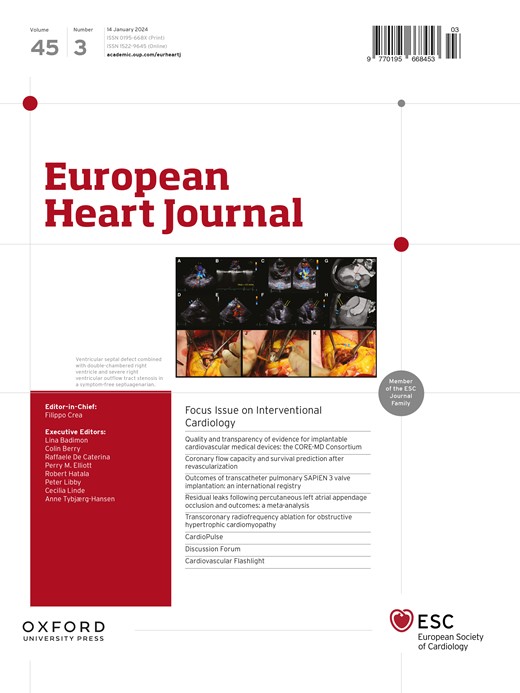Atrial cardiomyopathy: markers and outcomes
IF 35.6
1区 医学
Q1 CARDIAC & CARDIOVASCULAR SYSTEMS
引用次数: 0
Abstract
Background and Aims Atrial cardiomyopathy (AtCM) is increasingly recognized as an important substrate for atrial fibrillation (AF). This study aimed to examine potential markers and risk factors of AtCM, and associations with incident AF, heart failure (HF), and stroke. Methods Individuals from the UK Biobank with cardiac magnetic resonance imaging and electrocardiographic information were included. Atrial cardiomyopathy markers included left atrial dilation, left atrial mechanical dysfunction, P-wave prolongation, and abnormal P-wave terminal force. Risk factors for AtCM were assessed using logistic regressions. Incident AF, HF, and stroke according to AtCM markers were assessed in multivariable Cox-regression and cumulative incidence models. AF risk according to AtCM markers, clinical and genetic risk factors was evaluated by integrating the HARMS2-AF score and a polygenic risk score for AF. We used net reclassification improvement (NRI) to evaluate reclassification of risk when considering AtCM markers. Results Among 26 467 individuals, 4145 (15.7%) had ≥1 marker and 619 (2.3%) had ≥2 markers of AtCM. Age, coronary artery disease, and hypertension were consistently associated with AtCM. Having one AtCM marker conferred a hazard ratio (HR) for AF of 1.88 [95% confidence interval (CI): 1.54–2.31; P < .001], with higher rates observed in individuals with ≥2 markers (HR: 4.59; 95% CI: 3.52–5.99; P < .001). Addition of AtCM markers was associated with an NRI of 13.7% (95% CI: 9.2%–18.3%). Integration of clinical and genetic risk factors indicated an additive effect on AF rates. Having ≥2 markers associated with HF (HR: 3.08, 95% CI: 2.03–4.66, P < .001), and stroke (HR: 3.07, 95% CI: 1.78–5.28, P < .001). Conclusions One in seven individuals had at least one marker of AtCM. Atrial cardiomyopathy markers were associated with AF, HF, and stroke, supporting AtCM as a common substrate for all three outcomes.心房心肌病:标记物和结果
背景与目的心房心肌病(AtCM)越来越被认为是心房颤动(AF)的重要底物。本研究旨在探讨AtCM的潜在标志物和危险因素,以及与AF、心力衰竭和中风的关系。方法选取英国生物银行中具有心脏磁共振成像和心电图信息的个体。心房心肌病指标包括左心房扩张、左心房机械功能障碍、p波延长、p波末力异常。采用logistic回归评估AtCM的危险因素。根据AtCM标记物评估AF、HF和卒中的发生率,采用多变量cox回归和累积发生率模型。通过综合HARMS2-AF评分和AF的多基因风险评分来评估AtCM标记、临床和遗传风险因素的AF风险。在考虑AtCM标记时,我们使用净重分类改善(NRI)来评估风险重分类。结果26467例患者中有4145例(15.7%)有≥1个AtCM标记物,619例(2.3%)有≥2个AtCM标记物。年龄、冠状动脉疾病和高血压与AtCM一致相关。如果有一个AtCM标记,AF的风险比(HR)为1.88[95%可信区间(CI): 1.54-2.31;P, lt;.≥2个标记物的个体发病率更高(HR: 4.59; 95% CI: 3.52-5.99; P < .001)。AtCM标记的添加与13.7%的NRI相关(95% CI: 9.2%-18.3%)。综合临床和遗传风险因素表明,累加效应对房颤发生率。有≥2个与HF相关的标志物(HR: 3.08, 95% CI: 2.03-4.66, P <;0.001)和中风(HR: 3.07, 95% CI: 1.78-5.28, P < .001)。结论:1 / 7的个体存在至少一种AtCM标记物。心房心肌病标志物与房颤、心衰和卒中相关,支持AtCM作为所有三种结果的共同底物。
本文章由计算机程序翻译,如有差异,请以英文原文为准。
求助全文
约1分钟内获得全文
求助全文
来源期刊

European Heart Journal
医学-心血管系统
CiteScore
39.30
自引率
6.90%
发文量
3942
审稿时长
1 months
期刊介绍:
The European Heart Journal is a renowned international journal that focuses on cardiovascular medicine. It is published weekly and is the official journal of the European Society of Cardiology. This peer-reviewed journal is committed to publishing high-quality clinical and scientific material pertaining to all aspects of cardiovascular medicine. It covers a diverse range of topics including research findings, technical evaluations, and reviews. Moreover, the journal serves as a platform for the exchange of information and discussions on various aspects of cardiovascular medicine, including educational matters.
In addition to original papers on cardiovascular medicine and surgery, the European Heart Journal also presents reviews, clinical perspectives, ESC Guidelines, and editorial articles that highlight recent advancements in cardiology. Additionally, the journal actively encourages readers to share their thoughts and opinions through correspondence.
 求助内容:
求助内容: 应助结果提醒方式:
应助结果提醒方式:


